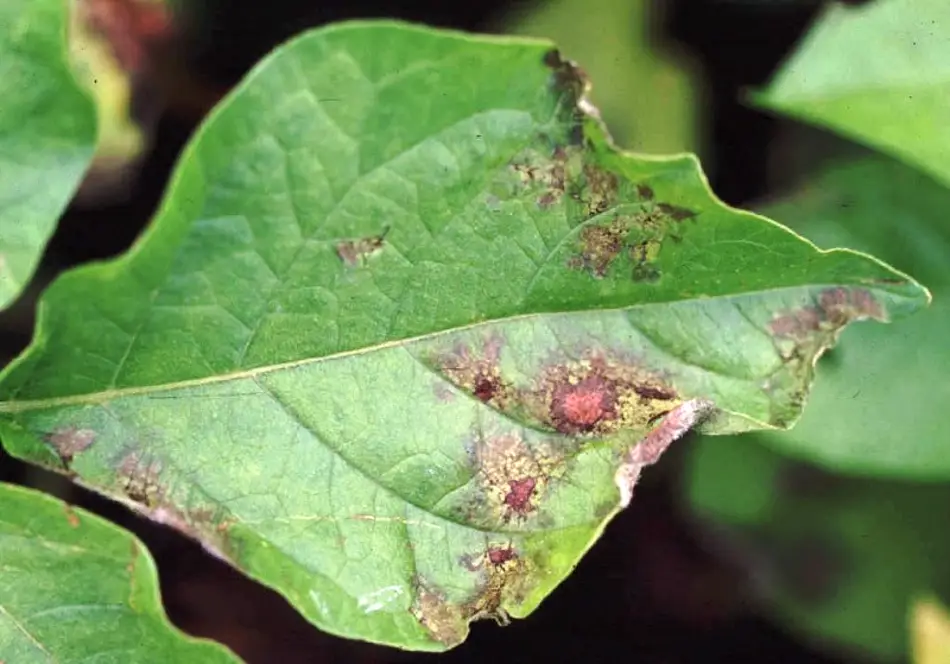Contents
- 1 CLASSIFICATION OF PHYTOPHTHORA
- 2 STUDY OF HOSTS, DISEASES AND SYMPTOMS OF PHYTOPHTHORA
- 3 STUDY OF VEGETATIVE STRUCTURE OF PHYTOPHTHORA
- 4 STUDY OF THE ASEXUAL REPRODUCTIVE STRUCTURES – SPORANGIA OF PHYTOPHTHORA
- 5 STUDY OF SEXUAL REPRODUCTIVE STRUCTURES – OOGONIA AND ANTHERIDIA OF PHYTOPHTHORA
- 6 IDENTIFICATION OF PHYTOPHTHORA
CLASSIFICATION OF PHYTOPHTHORA
Kingdom :- Mycota
Division :- Eumycota
Sub-division :- Mastigomycotina
Class :- Oomycetes
Order :- Peronosporales
Family :- Pythiaceae
Genus :- Phytophthora
STUDY OF HOSTS, DISEASES AND SYMPTOMS OF PHYTOPHTHORA
About 27 species of this genus are found in India. Some are facultative parasites (which live in the soil as saprophytes but develop as parasites in the presence of suitable host), whereas others are parasites on higher plants. Though these species are parasites in their natural habitat, nearly all of them grow on artificial culture media. Thus, parasitism in this genus is less specific.
Some of the diseases common in India are as follows :-
- Of all the species, P. infestans is economically the most important as it causes late or Irish blight of potato (Solanum tuberosum; vern, alu; fam. Solanaceae). The epidemics cause damage in hills and are not common to plains. Sometimes, besides the twigs, the mycelium may also invade the tubers and cause dry or wet rot. The first symptoms appear on the leaves as small black patches which increase in size with time. Infection soon spreads to the stems also and the entire shoot falls off in a few days if environmental conditions are suitable. After the tops have been blighted, the underground tubers are also affected. In the earlier stages there is discolouration of skin. Later infection spreads inwards, so that the entire tuber turns brown and decays giving off pungent odour.
- colocasiae causes the blight of Colocasia leaves and rot of succulent corms of Colocasia antiquorum (vern. arvi; fam. Araceae). In the blight of Colocasia, small, dark, roundish specks are formed on leaves. These widen rapidly by centrifugal growth and become circular, oval or triangular. If the conditions are favourable, the petioles and inflorescences also get infected, and in severe cases the corms may rot completely.
- arecae causes-koleroga of areca palms (Areca catechu; vern. supari; fam. Palmae), in western peninsular India. The preliminary symptoms appear on nuts as a water soaked area usually at the base. Ultimately the nuts loose their green colour and begin to fall. While the disease is predominantly on nuts, the tops of trees are occasionally attacked.
- palmivora causes bud rot of toddy palms (Borassus flabellifer; fam. Palmae) and coconut palms (Cocos nucifera; vern. nariyal; fam. Palmae), fruit rot of bread fruit (Artocarpus incisa, A. integrifolia), black leg of tobacco (Nicotiana) and brown rot and gummosis of Citrus spp.
- parasitica causes seedling blight of castor (Ricinus communis; vern, arandi; fam. Euphorbiaceae), leaf blight of sesame (Sesamum indicum; vern. til; fam. Pedaliaceae) and leaf and foot rot of betel (Piper betel; vern. paan; fam. Piperaceae). In seedling blight the cotyledons are blighted. Rotting of buds occurs in bud rot of various hosts.
- faberi causes bud rot of coco (Theobroma cacao) and Hevea, etc.
- phaseoli causes an abscission of the pods of Phaseolus lanatus (double bean; fam. Papilionaceae ).
- Phytophthora spp. causes damping off of brinjal (Solanum melongena), chillies (Capsicum annuum), tomato (Lycopersicon esculentum) and late blight of Cinchona spp.
STUDY OF VEGETATIVE STRUCTURE OF PHYTOPHTHORA
- Phytophthora is eucarpic, inter- or intracellular parasite.
- The young mycelium is profusely branched and non-septate but old hyphae at the time of reproduction is septate.
- Hyphae vary in diameter and develop finger-like haustoria which enter the cells of the host.
STUDY OF THE ASEXUAL REPRODUCTIVE STRUCTURES – SPORANGIA OF PHYTOPHTHORA
- Asexual reproduction takes place by sporangia or conidia.
- In a diseased patch, certain septate hyphae form the conidiophores which grow out from the stomata on the underside of the leaf.
- The conidiophore produces ovoid or lemon shaped, multinucleate, papillate (papilla lamellated) conidia which are at first terminal but become lateral later on, due to the sympodial branching of conidiophore.
- Each conidium forms many biflagellate zoospores which emerge through papilla. Each zoospore germinates to form a new mycelium
STUDY OF SEXUAL REPRODUCTIVE STRUCTURES – OOGONIA AND ANTHERIDIA OF PHYTOPHTHORA
- The sexual reproduction is of oogamous type.
- The antheridium may either be paragynous i.e. at the side of the oogonium e.g. P. cactorum or amphigynous i.e. at the base of the oogonium e.g. P. infestans. The latter condition is more common.
- The oogonium is spherical to pyriform, smooth and hyaline to yellowish. In the centre is an uninucleate oosphere.
- The antheridium has many male nuclei (multinucleate condition).
- At maturity, the antheridium pierces the oogonium by a fertilization tube. One male nucleus passes into the ooplasm.
- Male and female nuclei unite to produce oospore which develops a thick wall around itself.
- Oospore undergoes a rest for a few weeks or months. It gives out a germ tube on germination. It either develops into new mycelium or may form sporangium at its tip.
IDENTIFICATION OF PHYTOPHTHORA
- Kingdom – Mycota
- Chlorophyll absent
- Reserve food glycogen
- Cell wall of fungal cellulose.
- Division – Eumycota
- A definite cell wall present.
- Sub-division:- Mastigomycotina
- Presence of motile spores or zoospores.
- Class:- Oomycetes
- Usually mycelial (aseptate).
- Zoospores biflagellate.
- Order– Peronosporales
- Sexual reproduchon aplanogamic (gametes non-motile) and oogamous.
- Oogonia contain single egg surrounded by periplasm.
- Family – Pythiaceae
- Sporangiophores similar to somatic hypha, or if different, of indeterminate growth.
- Genus – Phytophthora
- Conidia formed sympodially.
- Zoospores liberate individually and not in a vesicle.


Leave a Reply